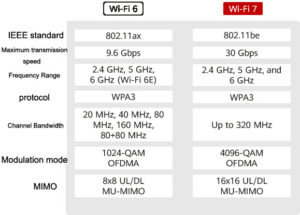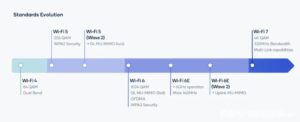On February 15, Qualcomm officially introduced WiFi 7 technology and said that Wi Fi 7 was about to open a new chapter in the field of connectivity. On Qualcomm’s official website, our innovative Wi Fi 7 solution sets the standard for the next generation of Wi Fi. Gives WiFi 7 high expectations. WiFi 7 has not appeared for the first time this time. In January 2022, MediaTek made its first show of WiFi 7, becoming the first enterprise in the industry to successfully complete the WiFi 7 technology demonstration.
WiFi 7 (Wi Fi 7) is the next generation Wi Fi standard, corresponding to IEEE 802.11. A new revised standard IEEE 802.11be – extremely high throughput (EHT) will be released. Wi Fi 7 introduces 320mhz bandwidth, 4096 QAM, multi Ru, multi link operation, enhanced MU-MIMO, multi AP cooperation and other technologies on the basis of Wi Fi 6, making Wi Fi 7 provide higher data transmission rate and lower delay than Wi Fi 6. Wi Fi 7 is expected to support a throughput of up to 30gbps, about three times that of Wi Fi 6.
Why Wi Fi 7?
With the development of WLAN technology, families and enterprises increasingly rely on Wi Fi as the main means of accessing the network. In recent years, new applications have emerged with higher requirements for throughput and delay, such as 4K and 8K video (the transmission rate may reach 20gbps), vr/ar, games (the delay requirement is less than 5ms), telecommuting, online video conferencing and cloud computing. Although the newly released Wi Fi 6 has focused on the user experience in high-density scenarios, it still cannot fully meet the needs in the face of the above higher requirements of throughput and delay.
To this end, the IEEE 802.11 standards organization is about to release a newly revised standard IEEE 802.11be eht, namely Wi Fi 7.
Release time of Wi Fi 7
The IEEE 802.11be eht working group was established in May 2019, and the development of 802.11be (Wi Fi 7) is still in progress. The entire protocol standard will be released according to two releases. Release 1 is expected to release the first draft draft1.0 in 2021, and the standard is expected to be released by the end of 2022; Release2 is expected to be launched in early 2022 and the standard release will be completed by the end of 2024.
Wi-Fi 7 vs Wi-Fi 6
Wi Fi 7 introduces many new technologies on the basis of Wi Fi 6 standard, mainly reflected in:

New features supported by Wi Fi 7
The goal of Wi Fi 7 protocol is to increase the throughput of WLAN network to 30gbps and provide access guarantee with low delay. In order to meet this goal, the whole protocol has been changed in PHY layer and MAC layer. Compared with Wi Fi 6 protocol, Wi Fi 7 protocol brings the following major technological changes:
Support maximum 320mhz bandwidth
The 2.4GHz and 5GHz bands have limited and crowded unlicensed spectrum. When running vr/ar and other emerging applications, existing Wi Fi will inevitably encounter the problem of low QoS. In order to achieve the goal of maximum throughput of not less than 30gbps, Wi Fi 7 will continue to introduce 6GHz band and add new bandwidth modes, including continuous 240mhz, discontinuous 160+80mhz, continuous 320 MHz and discontinuous 160+160mhz.
Support multi Ru mechanism
In Wi Fi 6, each user can only send or receive frames on the specific Ru allocated, which greatly limits the flexibility of spectrum resource scheduling. To solve this problem and further improve spectral efficiency, Wi Fi 7 defines a mechanism that allows multiple Rus to be allocated to a single user. Of course, in order to balance the complexity of implementation and the utilization of spectrum, certain restrictions are made on the combination of Ru in the protocol, that is, small-scale Ru (Ru less than 242 tone) can only be merged with small-scale Ru, and large-scale Ru (Ru greater than or equal to 242 tone) can only be merged with large-scale Ru, and the mixed use of small-scale Ru and large-scale Ru is not allowed.
Introduce higher-order 4096-qam modulation technology
The highest modulation mode of Wi Fi 6 is 1024-qam, in which the modulation symbol carries 10bits. In order to further improve the rate, Wi Fi 7 will introduce 4096-qam, so that the modulation symbol carries 12bit. Under the same coding, the 4096-qam of Wi Fi 7 can achieve a 20% rate increase over the 1024-qam of Wi Fi 6.
Introduce multi link mechanism
In order to realize the efficient utilization of all available spectrum resources, it is urgent to establish new spectrum management, coordination and transmission mechanisms at 2.4 GHz, 5 GHz and 6 GHz. The working group defined the technologies related to multi link aggregation, mainly including the MAC architecture of enhanced multi link aggregation, multi link channel access, multi link transmission and other related technologies.
Support more data streams and enhance MIMO functions
In Wi Fi 7, the number of spatial streams increases from 8 to 16 in Wi Fi 6, which can theoretically increase the physical transmission rate by more than twice. Supporting more data streams will also bring more powerful features – distributed MIMO, which means that 16 data streams can be provided by multiple access points at the same time instead of one access point, which means that multiple APS need to work together.
Support collaborative scheduling among multiple APS
At present, within the framework of 802.11 protocol, there is not much cooperation between APs. Common WLAN functions such as automatic tuning and intelligent roaming belong to the features customized by the manufacturer. The purpose of cooperation between APS is only to optimize channel selection and adjust the load between APs, so as to achieve the purpose of efficient utilization and balanced allocation of RF resources. The cooperative scheduling among multiple APS in Wi Fi 7, including the Coordination Planning between cells in time domain and frequency domain, the interference coordination between cells, and distributed MIMO, can effectively reduce the interference between APs and greatly improve the utilization of air interface resources.
There are many ways of collaborative scheduling among multiple APS, including c-ofdma (coordinated orthogonal frequency division multiple access), CSR (coordinated spatial reuse), CBF (coordinated beamforming) and JXT (joint transmission).
Let’s continue with Qualcomm’s latest introduction of Wi Fi 7 technology breakthroughs on February 15.
High speed and high bandwidth
The current Wi Fi 6 supports two bands: 2.4 GHz and 5 GHz: in the early Wi Fi, Bluetooth and other wireless technologies, 2.4 GHz has been shared to a large extent, and this band has become very congested; The 5GHz frequency band can provide more bandwidth than 2.4GHz, which translates into faster speed and greater capacity; Wi Fi 6e even supports the 6GHz band, while 5GHz and 6GHz are very suitable for activities with high bandwidth and low latency, such as streaming media and cloud games.

However, Qualcomm’s Wi Fi 7 solution has further broken through the limit of Wi Fi: in the future, the three frequency bands will be able to work at the same time, and the width of a single channel will be expanded from 160MHz of Wi Fi 6 to 320mhz. The peak transmission rate will exceed 40Gbps, four times higher than Wi Fi 6e. 5GHz and 6GHz are very suitable for activities with high bandwidth and low latency, such as streaming media and cloud games.

Meanwhile, compared with the 8 data streams of Wi Fi 6, Wi Fi 7 will support 16 data streams and cmu-mimo technology. Among them, C represents coordinated, which means that 16 data streams can be provided by multiple APS at the same time instead of one AP.
Multi link
Nowadays, access points (APS) usually provide support for three bands, and Wi Fi 7 will increasingly provide this support. Before Wi Fi 7, users could only use one of the frequency bands that best suits their needs. However, based on the multi link function, users can connect to the AP through multiple channels, which can be used to avoid congestion. For example, if there is traffic on one channel, the device can use the other channel to get a lower delay.
At the same time, according to the different availability in different regions, the multi link can use either two channels in the 5GHz band or a combination of two channels in the 5GHz and 6GHz bands.
In the multi link scheme, terminals such as routers use the first available frequency band for each transmission, and can select any frequency band for the next data transmission after the last transmission. In this way, congestion can be avoided and delays reduced.
High band simultaneous multi link function
At present, some regions can support three 320mhz continuous spectrum channels, some regions only support one channel, and even some regions do not support it at all.
For 5GHz frequency band, there is no continuous 320mhz frequency band, so only areas that support 6GHz can support this continuous mode. Through the high bandwidth simultaneous multi link function, the two frequency bands can be aggregated at the same time, and the throughput of the two channels can be aggregated, that is, a 320mhz effective channel can be formed through the combination of two 160MHz signals.
The advantage of this is that even if China does not allocate 6GHz spectrum, it can provide an effective channel of 240mhz through the high bandwidth synchronous multi link function, so as to achieve extremely high throughput in case of congestion.
Preamble punching
When the user has occupied part of the channel bandwidth, such as 20MHz or 40MHz, it usually prevents the AP from using this frequency band, causing a certain degree of waste. In response to this situation, Wi Fi 7 adopts an innovative solution called “preamble perforation”, which allows cutting the network and avoids using part of the spectrum containing interference signals while ensuring the availability of continuous channels. Although the total bandwidth will be reduced due to the number of perforations, it can still provide a wider channel than other methods.
4K QAM
In Wi Fi 6, the highest order modulation supported is 1024-qam, while Wi Fi 7 is standardizing a more advanced modulation scheme called 4K QAM. Compared with Wi Fi 6 modulated with 1K QAM, this scheme can improve the peak rate to increase throughput and data capacity. In this way, the final speed can reach 30gbps, which is three times the current 9.6Gbps WiFi 6 speed.
Application scenarios of Wi Fi 7
The new features introduced by Wi Fi 7 will greatly improve the data transmission rate and provide lower delay, and these advantages will be more conducive to emerging applications, as follows:
Video streaming
Video / voice conference
Wireless games
Real time collaboration
Cloud / edge computing
Industrial Internet of things
Immersive ar/vr
Interactive telemedicine
Spectrum policy worries
Not only Qualcomm, MediaTek, Hisilicon and other manufacturers are also actively deploying next-generation wireless networks such as Wi Fi 7. Wi Fi 7 will be built according to IEEE 802.11be extremely high throughput (EHT) standard, and it is expected that the formal version design will be confirmed from November 2023 to may 2024. In the future, Wi Fi will play an increasingly important role in our lives. It will be an important resource for both consumers and enterprises.
The Wi Fi 7 in your imagination is wonderful, but you will care. When can we use it?
The answer is – uncertain, and may even be completely unusable, because the commercial prospect of Wi-Fi 7 in China is still covered with a layer of “dark cloud”, and its performance has doubled, which requires the support of a very core resource – Radio spectrum. If the future spectrum policy is unfavorable, the commercial use of wi-fi7 will also encounter a “bottleneck”.
Previously, WiFi has been deployed in 2.4GH and 5GHz bands. However, with the rapid development of WiFi industry, the demand for radio spectrum resources is very urgent.
At present, countries have different attitudes towards the 6GHz (5925-7125mhz) band, which directly determines the fate of Wi Fi 6e and Wi Fi 7. These policies mainly focus on whether to allow WiFi access as an unauthorized frequency band, including three schemes:
(1) All 6GHz (5925-7125 MHz) can be used as unauthorized bands for WiFi
(2) The middle part of 6GHz (5925-6425mhz) can be used for WiFi as an unauthorized frequency band
(3) All 6GHz (5925-7125 MHz) are used as authorized frequency bands for cellular networks and other authorized access
For WiFi players, the first scheme is the most ideal scheme, which can use 1200MHz continuous frequency; The second scheme can use 500MHz continuous frequency, which can basically meet the current planning needs; The third scheme is the least desirable, which means that the plan of expanding Wi Fi 6e and Wi Fi 7 to 6GHz cannot be realized, and the possibility of commercial use is very small.
China has not yet given a clear policy on 6GHz, but from the public data, it seems that it is more inclined to use this frequency band as an authorized frequency band for 5g and 6G mobile communications. At present, China’s global leading edge in 5g development has been established, and China’s radio management department has also been committed to seeking more IMT frequency resources for 5g and future 6G technology from the perspective of efficient frequency use and long-term planning.
So, what is the future of Wi Fi 7? Let’s wait for the landing of spectrum policy.
